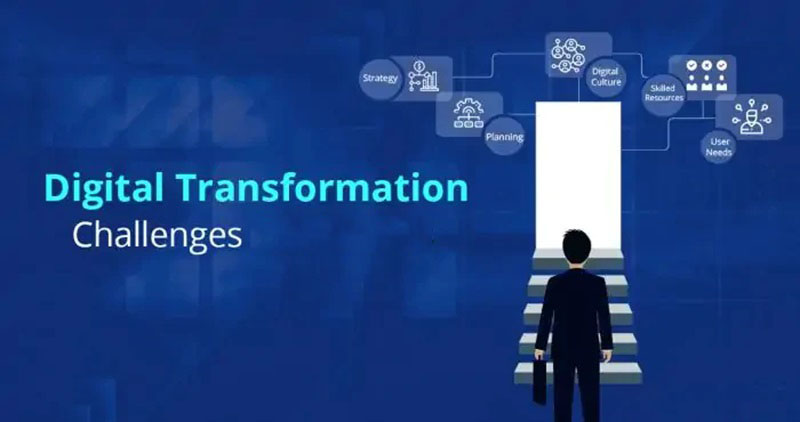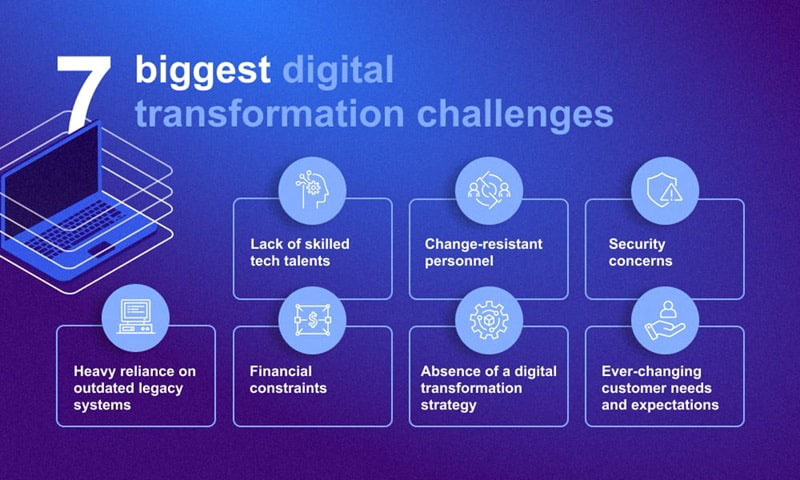The road to the future is digital, but it’s not without its bumps. Each twist and turn comes with unique digital transformation challenges. As we look to reinvent our businesses, we hit barriers. Tech adoption is tough. Old systems don’t want to fit with the new. And that’s just the start. People can resist change, and upskilling them is not easy. Teams might struggle to work together in new ways. Then there’s keeping all this safe. Hackers are waiting and new rules are written every day. How do we even tell if we’re winning? Let’s talk about getting your company across this digital finish line.
Understanding the Landscape of Digital Transformation Challenges
Identifying Common Obstacles in Digital Initiatives
In the digital world, we face big challenges. One is digital transformation obstacles. These block our path to grow with tech. We might trip on tech adoption hurdles. Or stumble over how to mix old and new systems together.
Now, think about change. Change is tough. People often push back when new tech comes. They like the old ways. But to stay ahead, we must adapt. This means teaching staff new skills.
Also, how do we keep safe? Cybersecurity worries pop up when we go digital. We must guard our info like a treasure. Another thing: when we buy new tech, does it help us make more money? This is key to figure out.
Addressing Technology Adoption Hurdles and Legacy Systems Integration
Then there’s tech adoption hurdles. Sometimes tech is hard to use or doesn’t fit right with the old stuff. Old systems don’t always want to play nice with new tech. They’re like distant cousins at a family reunion.
We also must move data without losing any. It’s like taking your toys to a friend’s house. You want to bring them all back home safely.
How we work with others matters too. Teams must talk and work together. One hand must know what the other is doing.
Remember, folks, staying ahead is not just about cool gadgets. It’s about knowing the game and playing it right. We must all grow with tech and face these challenges head-on. Each step forward can lead to a brighter future for our business.
The Human Factor: Change Management and Organizational Culture
Overcoming Resistance and Fostering Employee Upskilling
Let’s face it, people often fear new tech. They might worry they can’t keep up. So, winning hearts is key. Show folks how change helps them shine. Support staff as they learn. Give time, training, and cheer each win, big or small.
Offer courses for new skills. Let them see real gains from new tools at work. When people feel ready, they embrace tech. Happy teams lead. They push firms forward. A team set on learning stays sharp and useful. That’s a win for all.
Enhancing Interdepartmental Collaboration and Digital Literacy
Create teams that talk. Get sales, service, and IT in sync. Share goals and challenges. Make sure all have a say. When one group sees another’s struggle, they help. Help can mean quicker fixes and better ideas. It’s smart to cross-train. Let staff learn bits of others’ jobs. Mix skills and watch magic happen.
Grow digital know-how. Make tech smarts a must. Use clear, plain talk to teach. When everyone gets it, systems sync. Shared skills bond teams. This shared push drives firms to the top.
People power hits goals. Train, share, and grow together. Lead into a future that’s bright for both staff and business. Trust blooms when teams tackle tech together. What could be better?
Protecting Your Digital Frontier: Cybersecurity and Compliance
Cybersecurity Concerns in the Process of Digitization
When you go digital, you share data online. This can lure hackers. Your data could get stolen or damaged. To stay safe, you need smart security moves like using firewalls, malware tools, and secure passwords. Big firms might have a team to handle this. Smaller firms can struggle. They may not have the cash or know-how. This is tough, but you can’t ignore it. Cyber risks are real, and they can hurt your business.
Now, these challenges come in many forms. They include phishing attacks, where bad folks trick you into giving them your info. Then there’s ransomware. That’s when someone locks your data and asks for money. Always remember, your cybersecurity is as strong as your weakest link. It means everyone, from the boss to the temp, must know basic security steps.
You must also stay ready for new threats. Hackers always find new ways to break in. So, you need to always update your security plans. If this sounds like a lot, don’t worry. You can start small. Make sure all your team knows the cybersecurity basics. Simple things like not opening strange emails make a big difference.
Navigating Regulatory Compliance in a Digital Upgrade
When you upgrade to new tech, you must know the rules. Different places have different laws for data. For example, in Europe, there’s GDPR. It tells you how you must handle folks’ info. If you break these rules, you can get into big trouble. Big fines or worse. Before you go digital, you need to learn these laws.
You might need to change how you collect and keep info. It could mean new steps for protecting data. You’ll need to check with the experts to be sure you’re doing everything right. Don’t guess or hope. Laws change, and you must change with them.
Compliance is about more than avoiding trouble. It also builds trust. Your customers want to know their data is safe. If you follow the rules, they’ll feel better working with you. Also, doing it right can save you money. Breaking the law by mistake can cost a lot. So, it’s smart to get ahead of these issues. It’s better to spend some now than a lot later.
Both cybersecurity and compliance are key. They help as you change to digital ways. They protect your business and build trust with your folks and customers. It’s like a shield for your digital world. With it, you can face the digital future with less fear.
Measuring Success and Securing Future Growth
Determining the ROI of Digital Investments
When we put money into new tech, we ask, “Is it worth it?” In other words, we look at the return on investment (ROI) of digital updates. This tells us if the cost matches the gains. To figure this out, we check the increase in sales, savings from better operations, and higher customer satisfaction against the money spent on new digital tools and the work to put them into action. We also watch how fast these benefits show up. This helps decide if our digital steps are paying off.
Here’s the deal: a good ROI means your digital upgrades help your business more than they cost you. Let’s cut to the chase on how to ensure it. First, be clear on what you expect from your investment – higher revenue, more efficient work, or maybe better service for your customers. Then track these factors closely after you make changes. This way, you’ll see the direct effects of your digital steps. Also, remember adopting new tech can take time to show its true value. So, patience is key.
Scaling New Digital Solutions for Long-Term Success
After we know our new tech works and pays off, we face the next challenge. How do we grow it for ongoing success? Scaling tech means making sure it works not just for a few, but for all parts of your business. You need solutions that grow as you grow, without losing quality or creating new hurdles.
For winning at scaling, focus on flexibility and being ready for change. Choose options that expand with your needs. And think about your team – they need to be on board and skilled for these new tools. Plus, making sure all parts of your business talk to each other helps a lot. This means your sales, service, and accounting systems should work together.
In the end, constant check-ups on tech growth save you from hiccups later. And they ensure that your business keeps its edge. Take it slow and steady – solid steps now lead to big wins later. Aim for tech that adapts with you, training for your folks, and systems that fit like puzzle pieces. That’s your ticket to making digital updates help your biz soar for years.
In this post, we looked at the hurdles digital transformation can throw at you. We started by understanding the common pitfalls, like tech issues and old system woes. Then, we dove into the people part – dealing with pushback, teaching new skills, and getting teams to work together. After that, we faced the tough stuff: keeping data safe and following the rules as you go digital.
My final take? These challenges are real, but with the right approach, they’re not unbeatable. To win, you must sweat the small stuff – prep your tech and people. And always keep one eye on the goal – a safer, stronger, and smarter business in the digital world. Remember, a smart digital move today can lead to big wins tomorrow.
Q&A :
What are the most common obstacles faced during digital transformation?
Digital transformation involves integrating digital technology into all areas of a business, fundamentally changing how it operates and delivers value to customers. However, numerous challenges can arise during this process. Common obstacles include employee resistance to change, a lack of digital skills or expertise within the organization, the difficulty of integrating new technologies with legacy systems, budget constraints, and data security concerns. Addressing these issues requires a clear strategy, effective change management, and continuous education and training.
How can businesses effectively manage digital transformation risks?
Effectively managing the risks associated with digital transformation involves several key steps. Businesses need to conduct a thorough risk assessment to identify potential issues such as cybersecurity threats, compliance challenges, and operational disruptions. After identifying these risks, companies should develop a risk mitigation strategy that includes adopting secure technologies, providing employee training, and ensuring that all digital initiatives are in line with regulatory requirements. Continuous monitoring and adaptation are also essential to stay ahead of emerging risks in a fast-changing digital landscape.
What role does company culture play in overcoming digital transformation challenges?
Company culture plays a pivotal role in overcoming the challenges of digital transformation. A culture that embraces change, values innovation, and encourages continuous learning is better equipped to deal with the disruptions and adjustments that come with digital transformation. Cultivating such a culture involves leadership commitment, open communication, and fostering an environment where employees feel supported in acquiring new skills. Additionally, recognizing and rewarding adaptability and digital initiatives can help reinforce a positive culture shift.
How can leadership support a successful digital transformation?
Leadership support is critical for a successful digital transformation. Leaders can set a clear vision and direction for the digital initiative, communicate its importance and benefits throughout the organization, and allocate resources effectively. They should also embody the change they want to see, demonstrating commitment through their own actions and decisions. By actively engaging with teams, addressing concerns, and providing the necessary support and training, leaders can drive a transformation that aligns with organizational goals.
What strategies can organizations use to ensure ongoing digital transformation success?
For ongoing success in digital transformation, organizations should adopt a strategy that emphasizes agility, scalability, and continuous improvement. They need to stay informed about technological advancements and industry trends to remain competitive. Regular updates to digital tools and platforms, investing in employee digital literacy, and fostering a culture of innovation are crucial. Additionally, it’s important to measure the impact of digital transformation efforts and use data-driven insights to guide future initiatives, ensuring alignment with business objectives and customer needs.






